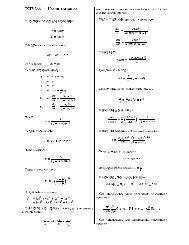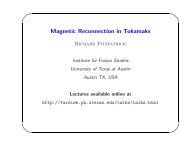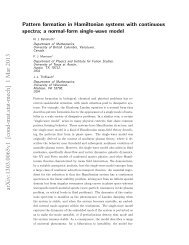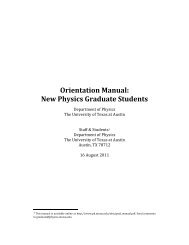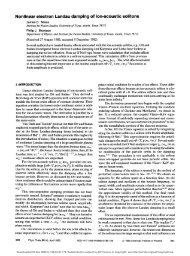Magnetic Fields and Magnetic Diagnostics for Tokamak Plasmas
Magnetic Fields and Magnetic Diagnostics for Tokamak Plasmas
Magnetic Fields and Magnetic Diagnostics for Tokamak Plasmas
You also want an ePaper? Increase the reach of your titles
YUMPU automatically turns print PDFs into web optimized ePapers that Google loves.
<strong>Magnetic</strong> fields <strong>and</strong> tokamak plasmas<br />
Alan Wootton<br />
θ * =<br />
φ = θ − a ⎛<br />
β I<br />
+ l i<br />
q MHD<br />
R ⎝<br />
g<br />
2 + 1 ⎞<br />
⎠ sin( θ)<br />
17.24<br />
i.e. the perturbing fields must have the <strong>for</strong>m (<strong>for</strong> r mn ≈ a)<br />
⎛<br />
b θ<br />
= b mn<br />
⎝<br />
r mn<br />
r<br />
m +1<br />
⎞<br />
⎠<br />
cos( mθ * + nφ − ω mn<br />
t) 17.25<br />
Figure 17.3 illustrates the field line trajectories in (φ,θ) space. Here we have assumed that<br />
α<br />
⎛<br />
q MHD<br />
( r) = q 0<br />
+ q a<br />
− q<br />
⎞<br />
0<br />
, with q<br />
⎝ ⎠ 0 the value at r = 0, q a the value at r = a (the plasma edge).<br />
( ) r a<br />
⎛<br />
This allows us to express r = a⎜<br />
q (r) − q MHD 0⎞<br />
⎟<br />
⎝ q a<br />
− q 0<br />
⎠<br />
1<br />
α<br />
. In the figure we show examples <strong>for</strong> a = 0.25 m,<br />
R g = 1 m, q 0 = 0.9, q a = 3.2, β I = 0.5, l i = 0.9. The solid lines are <strong>for</strong> q MHD = 3.2 (the plasma<br />
edge), <strong>and</strong> the broken lines <strong>for</strong> q MHD = 2. The shear in the q profile is apparent.<br />
φ<br />
θ<br />
Analysis techniques<br />
outside<br />
inside<br />
Figure 17.3. The trajectory of field lines in φ, θ space <strong>for</strong> q = 2<br />
(broken lines) <strong>and</strong> q = 3.2 (solid lines).<br />
With a set of Mirnov coils spanning a poloidal cross section of a low beta, circular cross section<br />
tokamak, we can take a Fourier trans<strong>for</strong>m in θ to obtain the amplitude of each component<br />
cos(mθ+nφ-ω mn t). If we have a rectangular vessel, then we have shown that the relevant<br />
expression is cos(mθ+θ+nφ-ω mn t). This has been done both computationally, <strong>and</strong> using analog<br />
multiplexing. We should allow <strong>for</strong> the toroidal corrections discussed above when per<strong>for</strong>ming<br />
this Fourier analysis; so that θ is replaced by θ*. Figure 17.4 shows the placement of the coils<br />
124










